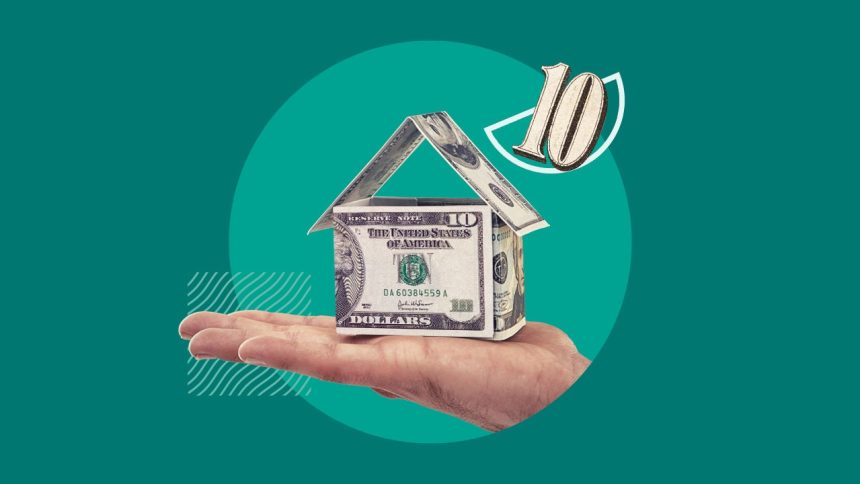Key takeaways
- A home equity loan or line of credit (HELOC) leverages your ownership stake to help you finance large expenses over time.
- Home equity financing offers more money at a lower interest rate than credit cards or personal loans.
- Some of the most common (and best) reasons for using home equity include paying for home renovations, consolidating debt and covering emergency or medical bills.
- Although allowable, it’s best to avoid using home equity for discretionary purchases and expenses.
Several things continue to imperil many Americans’ financial security. Shrinking savings, rising prices and high interest rates. Borrowing hasn’t been this expensive in 20 years and, to add insult to injury, it’s harder to get financing or credit, too. Half of Americans who’ve applied for a loan or financial product since March 2022 (when the Fed started raising its key benchmark rate) have been rejected, according to Bankrate’s recent Credit Denials Survey).
But, amid still-high mortgage rates and home prices, there’s a silver lining for homeowners. The rise in property values has increased the worth of their home equity, or outright ownership stake. You can borrow against that equity to meet new expenses — or settle old ones.
Two options to tap into your equity are home equity loans and home equity lines of credit (HELOCs). They may not be as well-known as other financing options (in the Bankrate survey, only 4 percent of Americans have applied for one since March 2022), but they have several advantages.
If you’re a homeowner needing cash, here are 10 reasons to use home equity — some better than others. In each case, we’ve noted the pros and cons.
$305,000
Amount the average mortgage-holder had in home equity as of as of Q1 2024, up $285,000 from Q1 2023
Source:
CoreLogic
What is home equity and why should you use it?
Home equity is the difference between what your home is worth and how much you still owe on your mortgage. As you pay down your mortgage and your home’s value increases, your equity stake grows.
If you’ve just closed on a home and need cash, you can generally tap into your home equity right away. However, some lenders require borrowers to wait several months before applying for a home equity loan or HELOC. And whether there’s a waiting period or not, you’ll have to meet the lender’s eligibility requirements. These can include credit score minimums, income verification and debt-to-income (DTI) ratio maximums. Most importantly, you’ll also need at least 20 percent equity in your home to qualify, though some lenders accept 15 percent.
What are the different ways you can access your home equity?
There are a couple of common ways that most homeowners can access their home equity.
Home equity loan
A home equity loan is a type of second mortgage in which you receive a lump sum upfront and then make regular monthly repayments over the loan term, usually at a fixed interest rate.
Home equity line of credit (HELOC)
A HELOC is a revolving line of credit, much like a credit card, that comes with a variable rate. You can borrow, repay and then re-use funds as needed during a set draw period and then pay off your balance during a repayment period.
10 reasons to use a home equity loan
There aren’t any restrictions on how to use equity in your home, but there are a few ways to make the most of a home equity loan or HELOC. Here are 10 ways to use your home equity, along with their pros and cons.
1. Home improvements
Home improvement is one of the most common reasons homeowners take out home equity loans or HELOCs. Besides making the home more comfortable, upgrades could make it more valuable.
“Home equity is a great option to finance large projects like a kitchen renovation that will increase a home’s value over time,” says Glenn Brunker, president of online lender Ally Home. “Many times, these investments will pay for themselves by increasing the home’s value.”
Another reason to consider a home equity loan or HELOC for renovations: You could deduct the interest paid on the loan, assuming you itemize your deductions on tax return.
Pros
- You are essentially putting the worth of your home to work, using it to increase the value of your property.
- If you itemize your tax deductions, you could deduct the interest on your home equity loan or HELOC, up to the limit.
- A HELOC, which allows gradual withdrawals, in particular can be ideal for long-term projects in which you pay contractors at set intervals, or ones in which the final cost is indefinite.
Cons
- The monthly payments on a home equity loan or HELOC, coupled with your monthly mortgage payments, could stretch your budget too thin.
- Depending on the scope of the remodel, you might need more than the amount you can borrow from your equity.
- If you can’t repay the home equity loan or HELOC, the lender could foreclose on your home.
2. Education costs
A home equity loan or HELOC can help you fund higher education or continuing education, whether for you, your children or other loved ones. This route typically only makes sense, however, when home equity rates are lower than student loan rates. That doesn’t happen often, especially with federal loans, but it might with private loans.
Consider, too, the type of education you’re financing. Someone obtaining a teaching certification, for example, might be able to get the cost covered by their future employer. Some public service professions are also eligible for student loan forgiveness after a period of time. In these cases, it wouldn’t be smart to put your home on the line with an equity loan.
Pros
- Could be a lower-interest option than a private student loan, a federal parent loan or a personal loan.
- HELOC gradual withdrawal structure is tailor-made for annual or semi-annual tuition payments.
- Could furnish a greater sum than a student loan.
Cons
- Repayment starts sooner (with a home equity loan).
- Rates not as competitive as federal student loans’.
- Tapping home equity is riskier: If you default, you could lose your home.
- The student might be able to get financial help in other ways, such as from a future employer or via loan forgiveness.
3. Debt consolidation
Americans’ credit card debt is skyrocketing. According to Bankrate’s most recent credit card survey, one half of credit card holders currently carry a balance from month to month — a four-year high. Given their average interest rate of 22.63 percent, paying down that debt can be tricky, not to mention expensive.
A HELOC or home equity loan can be used to pay off the plastic, along with other high-interest loans. “This is another very popular use of home equity, as one is often able to consolidate debt at a much lower rate over a longer term and reduce monthly expenses significantly,” says Matt Hackett, operations manager at mortgage lender Equity Now.
According to Bankrate’s Home Equity Insights Survey, 30 percent of U.S. homeowners consider debt consolidation a good reason to tap home equity.
Pros
- You could save on interest and lower your monthly payments.
- Eliminating credit card debt boosts your credit score.
Cons
- You’re turning an unsecured debt, such as a credit card, into secured debt now backed by your home. If you default on your equity loan or HELOC, you could lose your house to foreclosure.
- If you haven’t broken the financial habits that got you into debt in the first place, or come up with a plan for repayment, you’re simply swapping one form of debt for another.
4. Emergency expenses
Many financial experts agree you should have an emergency fund to cover three to six months of living expenses, but that’s not the reality for many Americans, according to Bankrate’s 2024 annual Emergency Savings Survey. If you find yourself in a costly situation — maybe you’re facing large medical bills or unexpected home repairs — a home equity loan or HELOC can be one way to stay afloat.
However, this is only a viable option if you have a plan for how to repay the debt. While you might feel better knowing you could access your home equity in case of an emergency, it still makes smart financial sense to set up and start contributing to an emergency fund. Plus, the application process for a HELOC or home equity loan takes time (though it’s speeded up of late: Some online lenders, such as Better, are offering approval decisions within one day). In a true emergency when you need cash fast, you’d need to already have the loan in place to use it.
Pros
- If you’re in an emergency and have no other source of cash, a home equity loan or HELOC could be the answer.
Cons
- If you don’t have a HELOC or home equity loan already established, you’ll need to complete the application process first. So these loans won’t do you any good in an extremely time-sensitive emergency.
- You’re depleting your ownership stake, diluting the worth of a major asset: your home.
5. Weddings
The average cost of a wedding in 2023 was $35,000, according to the planning site The Knot — up $5,000 from 2022. For some couples, it might make sense to take out a home equity loan or HELOC to cover this expense, rather than a wedding loan, a type of personal loan. That’s because the interest rates on personal loans are typically higher than interest rates for home equity loans and HELOCs.
The major disadvantage, however: You’d be putting your home on the line for a discretionary expense. This can be risky if you don’t have a solid plan to repay the loan. It also tacks on interest to an expense that didn’t have interest to begin with, ultimately costing you more.
If you do go this route, be careful not to take out more than you need. If you’re unsure of the total tab for your big day, a HELOC is the better option.
Pros
- Rates probably cheaper than those of personal loans or credit cards.
- You may be able to access a larger amount than you would with other loans.
Cons
- It’s a questionable move to put your home on the line for what’s essentially a big party.
- Your wedding will cost more than you think, thanks to the loan interest, and you could be paying for it decades after you marry.
- When the loan’s used this way, the interest isn’t tax-deductible.
6. Business expenses
Some business owners use their home equity to start or grow their company. If you need capital, you might be able to save money on interest by taking equity out of your home instead of taking out a business loan. Before you commit, though, run the numbers. A return on investment isn’t guaranteed, and you’re putting your house on the line.
Pros
- You might be able to borrow money at a lower interest rate with a home equity loan than you would with a small business loan.
- It might be easier to obtain capital with a home equity loan than with a loan tied to your business, especially if you’re just starting out.
Cons
- If your business fails, you’d still need to make payments on what you borrowed, regardless of lack of earnings. If you can’t, you could face foreclosure.
7. Investment opportunities
It’s possible to use home equity to invest in the stock market; or buy a rental property — though both propositions are risky and require serious care and consideration. A well-qualified borrower might be able to take out a home equity loan on an investment property they own, as well.
Using home equity for this purpose particularly resonates with younger homeowners. According to Bankrate’s Home Equity Insights Survey, almost one-third (30 percent) of millennial homeowners consider making investments a good reason to tap home equity.
Consider the cost of home equity borrowing, though. “With interest rates of 9 percent, 10 percent or even higher, this is no longer low-cost debt,” says Greg McBride, CFA, Bankrate’s chief financial analyst. “At rates that high, it is a tough hurdle to clear to get a positive return on your investment.”
Pros
- Investing in the stock market or real estate sets you on the path to building wealth, and the sooner you can start, the better.
- Leveraging assets to invest increases your rate of return.
Cons
- It’s possible that you won’t earn a high enough return to outweigh the loan interest you pay.
- You’re stuck with the debt, even if your investments decline in value.
- You can’t take advantage of the home equity loan’s tax deduction on interest, except in a few cases, such as buying adjacent property or land.
8. Retirement income
If your retirement savings are falling short, tapping home’s equity can help supplement your income so you can better manage expenses. These funds can be used to cover bills, emergency expenses or even home improvements to make you more comfortable as you age. A big caveat: This strategy relies on your ability to repay the loan or HELOC. If you’re not yet drawing Social Security, you might be able to repay HELOC funds with the benefit money later on. If you’re fully retired and struggling to make ends meet, however, it’s possible you won’t have the means to repay the debt, even if you have a HELOC you don’t have to pay back right away.
There are other roadblocks to this strategy, too: If you’re still paying your first mortgage, tapping your equity adds to your expenses and puts you in debt that much longer. It might also be harder to even get an equity loan if your income has decreased in retirement.
Pros
- If you need to beef up your retirement income, why not borrow from your own assets — it can make more sense than selling investments.
Cons
- You’ll need to think through how to repay your loan while you’re retired, and even afterwards. Home equity debt doesn’t disappear when you pass away — your heirs will have to work with your lender if they want to keep the home.
- It could be harder to qualify for a home equity loan with a lower retirement income.
If you need retirement income, a reverse mortgage may be a better option than a home equity loan or HELOC. With a reverse mortgage, your lender pays you a lump sum or a series of monthly payments; how much you can get is based on your home’s value. The loan balance (plus interest) becomes due when you move out, sell the home or pass away. Most reverse mortgages include a “non-recourse” clause, which stipulates that you (or your estate) can’t owe more than the home’s value when the loan becomes due (so if the home’s depreciated and worth less than the loan balance, no one is on the hook for the difference).
The advantages: There are no monthly repayments while you’re living in the home, and there are no income or credit score requirements, so you can qualify even if you’re struggling financially. However, to get a reverse mortgage, you usually need to be 62 or older and have substantial equity in your home — meaning, your primary mortgage be substantially, if not entirely, paid off.
9. Funding a vacation
Traveling can come with a steep price tag, and tapping your home’s equity could help cover the costs without having to increase your credit card debt. Even the best vacations don’t last forever, though, and home equity debt can linger for decades, so weigh your decision carefully. Is the trip worth potentially risking your house to pay for?
Pros
- Home equity loans typically have lower interest rates than credit cards, which could save you money.
Cons
- Putting your home on the line is an extremely risky way to finance a trip that will be over in a matter of days — and you’ll still be paying for it many years after it’s over, which could ultimately cost you more in interest.
10. Other big-ticket items
It’s possible to use your home equity for big-ticket purchases, but it doesn’t add up in many cases. Home equity loans have much longer repayment terms than auto loans, for example, resulting in lower monthly payments. But that also means paying much more interest over time. Cars are also depreciating assets, meaning your car will be worth much less than you paid for it by the time you finish repaying the equity loan.
Pros
- You could finance a larger purchase, like a car.
Cons
- Your home’s equity isn’t worth leveraging on an expense that won’t give you a solid return. With the example of buying a car, you’ll be risking your home for an asset that will be worth less than what you paid for it by the time you’ve finished repaying the loan.
How do I calculate how much home equity I can borrow?
With a home equity loan, most lenders allow you to borrow as much as 80 percent to 85 percent of your combined loan-to-value (CLTV) ratio. It’s called “combined” because it considers both your current mortgage and any additional loans you’d take on.
CLTV is calculated by taking the total amount you would owe in home-based debt and dividing it by the total value of the home. For example, if your home is worth $450,000, and you have an outstanding mortgage amount of $200,000, and you would like to take out a home equity loan for $50,000, here’s how to calculate CLTV:
($200,000 + $50,000) / $450,000 = 0.56 X 100 = 56% CLTV
You can also use a home equity loan calculator to help you understand how much you could borrow.
Using home equity FAQ
-
The amount of home equity you can borrow against depends on a number of factors, including how much the home is worth, the outstanding balance on your mortgage and your credit score. Assuming you’re well-qualified, many home equity lenders allow you to tap up to 80 percent of your equity.
-
As with any loan product, a home equity loan or HELOC can hurt your credit score in the short term, in part because you’re taking on more debt and potentially raising your credit utilization ratio. Over time, however, your credit score could go up as you make regular monthly payments on your home equity loan. It’s possible to get a home equity loan with bad credit, too.
-
It can be. You can deduct home equity loan interest if you use the funds to “buy, build or substantially improve” the home that was used to secure the loan, according to the IRS. You must itemize deductions on your tax return, and — similar to the mortgage deduction — there are limits as to how much you can deduct.
-
Yes. The closing costs for home equity loans and HELOCs can range from 1 percent to 5 percent of your loan amount. These can include many of the same closing costs as a typical real estate closing, such as origination, appraisal and credit report fees. HELOC lenders also often charge annual fees to keep the line open, as well as an early termination fee if you close it within three years of opening. You could also incur a charge if you decide to convert your HELOC balance to a fixed interest rate.
Read the full article here














